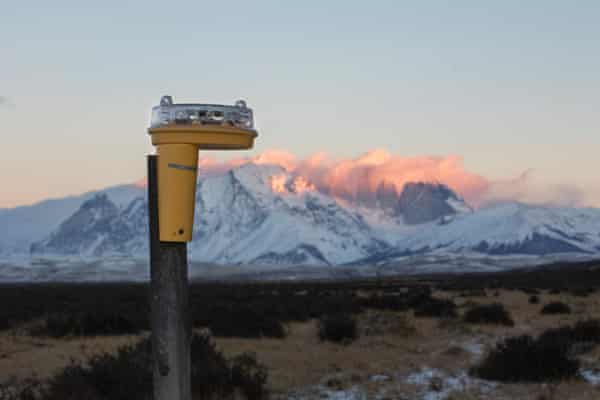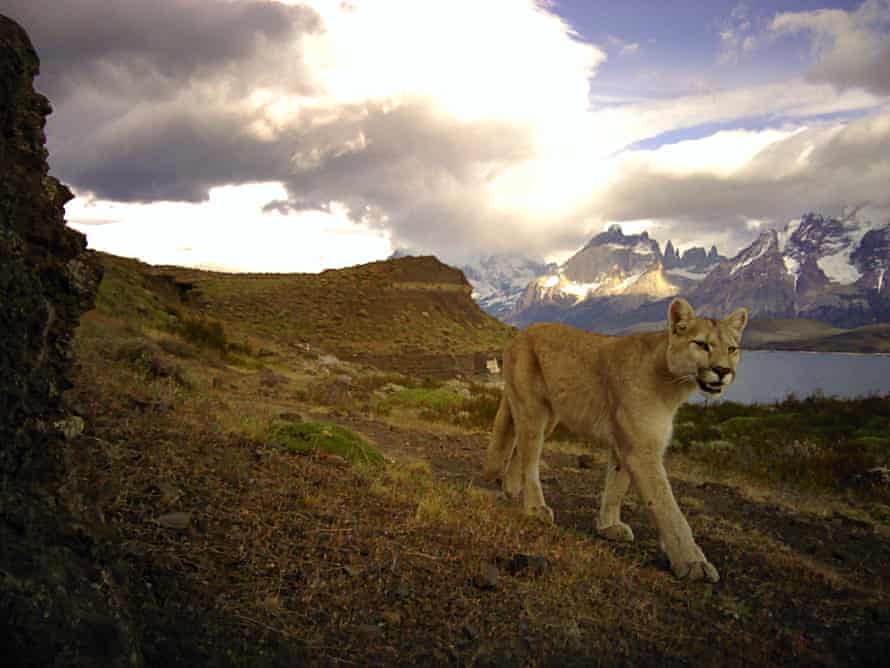Lights, dogs, action! Patagonia project to keep pumas from preying on sheep
A trial using maremma sheepdogs and Foxlights is offering a new way to protect livestock and diffuse conflict with ranchers over the big cats

Arriving at a fencepost protruding like a needle from the grassland, conservation adviser Nicolas Lagos assembles an LED device that will sit atop the pillar and at nightfall emanate an eerie multicoloured display across the frosted Patagonian valley below. The lights emit random 360-degree patterns visible from a mile away. Known as Foxlights they emulate human torch movement and scare away pumas threatening 20,000 sheep at the nearby Estancia Cerro Guido, on the outskirts of Chile’s Torres del Paine national park.

The LEDs are just one part of efforts to diffuse a polarising conflict over the big cats. “Talking about success with deterrents to ranchers who have always killed pumas isn’t enough,” says Lagos, who is working on the project at the 100-hectare Estancia Cerro Guido. “With robust results, we hope to start changing attitudes.”
Alongside the Foxlights an altogether different deterrent is being trialled: maremma dogs.
Maremmas are highly specialised sheepdogs; innate caregivers who at 45kg and with fluffy white coats match their woollen wards in size and appearance. The dogs are born among sheep herds, imprinting on them and creating an early cross-species protective bond. For centuries they have deterred wolves in Italy. Now they are proving effective at protecting sheep against pumas, which are ambush predators and flee when exposed. The dogs are nomadic and roam wherever the herd goes.
After introducing maremmas in 2017, Estancia Cerro Guido saw a 30% drop in sheep killings. It has also seen success from seven Foxlights since February.
Foxlights self-charge with solar panels and were invented thousands of miles away by Australian farmer Ian Whalan, who designed them to deter foxes. They are being used in southern Chile after Omar Ohrens, a conservation scientist for New York’s big cat NGO, Panthera, successfully trialled them in northern Chile, helping indigenous Aymara shepherds protect llamas and alpacas.
But demonstrable data is being sought to convince others to follow suit with non-lethal deterrents in Chile’s Magallanes region, where Pumas have been hunted for nearly 150 years, since the introduction of sheep.
The estancia and Panthera are following up on the adhoc use of Foxlights and maremma dogs with a four-year experiment launched in March that will amass data from a carefully controlled 5,000-hectare section of the ranch. Four maremmas are already at work, and in October, when the sheep move to the summer fields, they will introduce 20 monitored Foxlights. Puma frequency and behaviour will also be recorded using camera traps and GPS collars.
“The sheep are a business for these people,” says Lagos. “The numbers mean everything, so our data has to be good.”

Project director Pia Vergara has been photographing pumas for 18 years in Patagonia. One of the best places to see them is in the Torres del Paine and surrounding areas. She thinks the project could help restore environmental equilibrium in Magallanes. “The non-lethal measures are leading local individuals to return to natural sources of food, like guanacos, rheas, and hares, which is better for the ecosystem,” she says.
In a study, led by Ohrens, 45 ranchers interviewed said that pumas accounted for a costly 19% of annual sheep losses. However, when co-investigators tallied the figures, it was just 0.5% of holdings losses. “There is a mismatch between perception and reality, and we want to objectify what really happens,” says Vergara.
Coexistence at the site was first imagined in 2013. The estancia’s owners, the Simunovic and Matetic families, noticed a growing demand for puma tourism and wanted to combine it with livestock farming and align with conservation efforts, which increased in the early 2000s in Chile.
Pumas, also known as mountain lions, among dozens of other names, range across almost the entire latitude of the Americas. They are Chile’s top predator with an important role in biodiversity and ecological resilience, despite being of “least concern” on the IUCN’s red list.
“It’s hard to get reliable numbers with such an elusive cat,” says Ohrens. “Estimates like IUCN’s talk about the global population but don’t account for local ones that may be threatened.”
Pumas have been protected in Chile since the 1980s, but are still hunted on farmlands surrounding Torres del Paine by leoneros (lion men) – Patagonian hunters with dogs. There are no formal estimates on how many pumas are killed, but continued clandestine hunts are common knowledge. “This area has seen livestock farming for 150 years, and it’s a tradition to kill pumas,” says Ohrens. “Leoneros have a revered status, and for some it’s even a form of employment.”

Ohrens’ study provides some evidence that Chile’s tourism drive is changing local ranchers’ attitude towards pumas. He and his team compared rancher interviews before and after the tourism boom began, between 2005 and 2018, and found that many now recognise the puma as important to Patagonian heritage.
Tourism has created lucrative opportunities for those offering high-end packages with guides and gear, and some ranches have switched entirely to these ventures. But many remain reluctant, favouring ancestral practices.
One suggestion has been to share revenue from puma tourism to compensate farmers who lose sheep to the predators. “However, the evidence suggests that financial incentives do little to change attitudes,” says Ohrens. “Everything has to be tested, and convincing different groups to agree on sharing revenue is not easy.
“Using working examples of what’s possible could serve as an incentive for other ranchers, which may later become a social norm. That’s when things appear to really change.”
Find more age of extinction coverage here, and follow biodiversity reporters Phoebe Weston and Patrick Greenfield on Twitter for all the latest news and features
